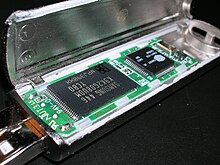Conversation started Jun 10, 2017 at 2:53.
Jun 10, 2017 02:53
@FaheemMitha NAND flash memory has been in short supply for more than a year already due to skyrocketing demand for high-performance NAND in devices like smartphones and SSDs, and flash memory manufacturers have had far more trouble than expected transitioning to 3D NAND.
TLC NAND is cheaper per GB than MLC NAND because it can store 50% more data, but it has lower performance and endurance. Due to cost pressures, exacerbated by the NAND shortage, production of MLC NAND is now very limited and reserved for high-end products.
Devices consisting of SLC NAND (one bit per cell) are extremely rare as true SLC NAND no longer manufactured in quantity. Although SLC NAND has extremely high performance and endurance, it is also very expensive because of its low storage density.
Most SSDs that use TLC NAND run a portion of it in SLC mode as a high-performance write buffer, aiming to hide the low performance of the TLC NAND. This buffer also allows the SSD to combine small random writes into larger sequential writes which helps increase endurance. This buffer is typically only a few GBs in size; large sequential writes can exhaust this buffer, resulting in reduced performance, sometimes to the point where the SSD performs slower than a hard drive.
Typically, the drive flushes this SLC buffer in the background when it is not busy writing data. For most lighter consumer workloads, the slow performance of the underlying TLC NAND is not visible, but large file transfers onto the SSD can exhaust the SLC buffer. As for how combining random writes into sequential writes helps increase endurance, read up on write amplification.
Dec 14 '16 at 19:09, by Mokubai
@djsmiley2k TLC NAND is slow, so they put some real fast SLC NAND in front of it, and when the SLC gets overwhelmed the TLC speeds show through and you get a drive that looks more like spinning rust than silicon.

A solid-state drive (SSD, also known as a solid-state disk) is a solid-state storage device that uses integrated circuit assemblies as memory to store data persistently. SSD technology primarily uses electronic interfaces compatible with traditional block input/output (I/O) hard disk drives (HDDs), which permit simple replacements in common applications. New I/O interfaces like SATA Express and M.2 have been designed to address specific requirements of the SSD technology.
SSDs have no moving mechanical components. This distinguishes them from traditional electromechanical magnetic disks such as...

Flash memory is an electronic (solid-state) non-volatile computer storage medium that can be electrically erased and reprogrammed.
Toshiba developed flash memory from EEPROM (electrically erasable programmable read-only memory) in the early 1980s and introduced it to the market in 1984. The two main types of flash memory are named after the NAND and NOR logic gates. The individual flash memory cells exhibit internal characteristics similar to those of the corresponding gates.
Where EPROMs had to be completely erased before being rewritten, NAND-type flash memory may be written and read in blocks...
In electronics, a multi-level cell (MLC) is a memory element capable of storing more than a single bit of information.
MLC NAND flash is a flash memory technology using multiple levels per cell to allow more bits to be stored using the same number of transistors. In single-level cell (SLC) NAND flash technology, each cell can exist in one of two states, storing one bit of information per cell. Most MLC NAND flash memory has four possible states per cell, so it can store two bits of information per cell. This reduces the amount of margin separating the states and results in the possibility of more...

Write amplification (WA) is an undesirable phenomenon associated with flash memory and solid-state drives (SSDs) where the actual amount of information physically written to the storage media is a multiple of the logical amount intended to be written.
Because flash memory must be erased before it can be rewritten, with much coarser granularity of the erase operation when compared to the write operation, the process to perform these operations results in moving (or rewriting) user data and metadata more than once. Thus, rewriting some data requires an already used portion of flash to be read, updated...
@FaheemMitha and others, if you'd like to discuss this in further detail, come to my PC hardware news chat room.
TL;DR: A NAND shortage is resulting in high prices and limited availability of SSDs. MLC NAND is becoming very scarce as manufacturers shift production to cheaper TLC NAND in an effort to meet skyrocketing demand for flash memory. TLC NAND is less desirable than MLC NAND because it's both slower and has lower endurance. For most consumers, this is not an issue, but it's bad news for enthusiasts who want the fastest, most durable parts for their PCs.
Conversation ended Jun 10, 2017 at 3:15.
Of NAND, SSDs, and the NAND shortage
Jun '1710
Participants
- bwDraco 100%
all times are UTC
